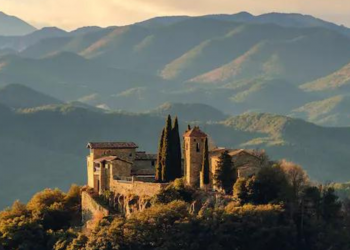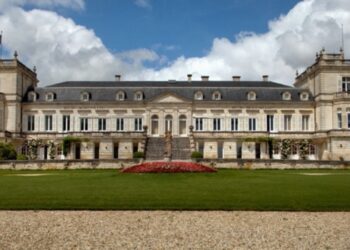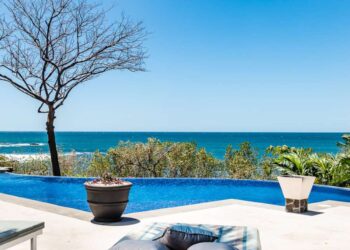The Azores, an archipelago of nine islands in the middle of the Atlantic that are a semi-autonomous region of Portugal, still feel like something of a well-kept secret. There are tourists, of course, but not all that many and mainly of a certain stripe: people who care about nature, design-driven small hotels, adventure, excellent food and wine, and authenticity. (And people who don’t care about rain — the climate can be unpredictable, but that’s why the islands are so green.)
Each of the islands has its own personality and landscape, having been formed by different volcanic events thousands of years apart. São Miguel, the most populated one, is known as the green island for its incandescent landscapes. Pico (“peak” in Portuguese) is named for its mountain that looks like a child’s drawing of a volcano, and Terceira is famous for its festivals. I can’t pick a favorite of those three (the ones with the best flight connections) but take any opportunity I get to visit any of the islands in the group.
The Landscape of São Miguel
São Miguel more than lives up to its “green island” billing, with shade upon shade of green grass and plants and trees. There are blue and purple hydrangeas all along the roads, planted just because they anchor the soil. (The beauty is a bonus.) The best spots to appreciate wild nature on the island include Sete Cidades (“seven cities,” but actually seven volcanic craters that have filled in with vegetation), Lagoa Azul (“blue lagoon,” self-explanatory), and Ribeira dos Caldeirões (“hot springs stream,” in which you can go canyoning. If manicured nature is more your thing, there’s the lush botanical garden at Terra Nostra in Furnas.
Fabulous Boutique Hotels
The best places to stay are the tiny ones with a strong sense of place. São Miguel has led the way with smart, design-forward hotels, such as the minimalist White (recently improved with a thoughtful redesign) and Sul, and also Senhora da Rosa Tradition & Nature Hotel, a passion project that began when a seasoned international hotelier bought her parents’ old, abandoned hotel and set about bringing it back to life. On Pico, Lava Homes is known for its soulful style and breathtaking views, and it was recently joined by a lovely new villa called Adega do Fogo. And the Caparica Azores Ecolodge in Terceira is a collection of dreamy little cabins in the forest.
The World’s Best Pineapple
São Miguel’s pineapples are a specific species that’s smaller and sweeter than most of the world’s pineapples. (And everyone knows that a fresh pineapple is always better than one that has traveled by boat.) Historically they were a major source of wealth for the island, and they continue to be an important product. The pineapple interpretive center in Fajã de Baixo is worth a visit, both for its explanation of the difficult farming involved and for its collection of vintage advertisements. At Senhora da Rosa, the working pineapple greenhouse now also houses a small swimming pool.
The Gin Library
I got to know Ali Bullock—probably São Miguel’s most colorful character — through his new gin, called Baleia (“whale” in Portuguese), which contributes to his Ocean Azores Foundation. (He’s literally out to save the whales.) When he arrived on the island several years ago, he brought his collection of gin and set up a bar where visitors can try Baleia and some of the 600-plus other gins he has on the shelves. Along with the gin bar, he’s working on restoring an old estate as a sustainable guest house (Solar Branco Eco Estate), set to open next year.
The Art of Tasting Portugal Food Experiences
I confess that I was skeptical when I first heard about the Art of Tasting Portugal, which sounded like little more than marketing. I was wrong. In São Miguel, chef Cláudio Pontes and sommelier João Couto, showed me some of the island’s most special, memorable experiences. We stopped at the organic farm and social project Kairos, which supplies food to many of the top restaurants; the Gorreana tea plantation; and the geothermal cooking pits near Furnas, where traditional meat stew (or in my case, cake-like bread) is slow-cooked for hours underground. Then, in a small fishing village, they handed me over to Bruno Raposo of Há Mar, who took me out on a fishing boat with a longtime fisherman (it’s also possible to go out early with them and actually catch fish) while the chef and host got to work in the backyard of a private home with an incredible view, setting up a fire kitchen and serving a outstanding, super-fresh fish lunch in which everything was cooked over the flames, and in which the conversation flowed as easily as the Azorean wines.
Pico’s Wines
After having been brought back from near extinction, the native grapes of Pico island have become the most prized in Portugal, commanding prices on par with Champagne, Bordeaux, and Napa Valley grapes. They make outstanding whites, unusual for their volcanic minerality and seaside salinity — the old phrase is that they make wine where they can hear the crabs singing. The vineyards are fascinating, with their miles and miles of black basalt walls to warm the vines, and the products they produce are outstanding. The best place to try them is the Pico Wines cooperative, in the center of the biggest town, Madalena, and the Azores Wine Company, the project cofounded by rockstar winemaker António Maçanita, who did the research to recover the forgotten grapes and put Pico back on the international oenophile map, and which opened a handful of beautiful guest rooms last year. And then there’s Czar, a project that’s hard to classify: The wines are strong but not fortified (nor sweet), harvested late but not “late harvest,” and sometimes called “raisin wines” in Portuguese but that sounds unappetizing in English. Just call them delicious.
Pico’s Mountain
The highest peak in Portugal (7,713 feet, but still) is a relatively non-technical climb. There’s no trail, but because Pico is a young island (only 300,000 years, nothing in geologic time, with eruptions until the 18th century) the rugged lava rocks provide great traction for hiking boots. Many people make their way up to the crater, sleep inside it, and then summit Piquinho (“little peak”) around sunrise. I don’t camp, so I passed on this and instead did a day up and down with Tripix, whose founders lead private and small group climbs, with just the right mix of caution and encouragement (honed over more than 400 trips up the mountain).
Rainha do Pico Butter and São Jorge Cheese
It’s a good thing I climbed that mountain, because the butter in Pico is seriously good — creamy, mild, and delicious. In fact, as one would expect of islands in which cows outnumber people by a good margin. The best-known cheeses are the sharp ones from the island of São Jorge (served on all the islands), which are sometimes aged for 24 or 30 months, until they take on the crystallized structure of a top-quality Parmesan.
Terceira’s Impérios
It’s logical that on actively volcanic islands, at a time when science couldn’t yet explain the eruptions, people took great interest in the Holy Spirit. This led to a variety of ceremonies and also to the creation of impérios, little chapels with confectionary architecture and vivid color combinations. Azorean church architecture is generally beautiful, but these are something else. There’s no need to go inside, but you pass by them all over the island.
Terceira’s Festivals
Those ceremonies evolved into a freewheeling party season, where people gather on the streets most nights of the summer to celebrate with music and special foods, including a rump steak dish called alcatra. Locals like to brag that the Azores are eight islands and an amusement park. The most unusual festivals are those that involve bulls — they call it bullfighting, but that’s a misnomer as there’s no fighting or aggression. Rather, the bulls are encouraged to play on city streets as people line up to cheer them on. Some locals really get into this, developing stronger feelings for their favorite bull than their favorite footballers. Tourists are always welcome.







